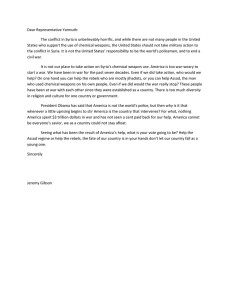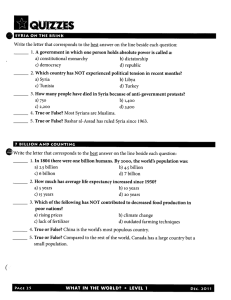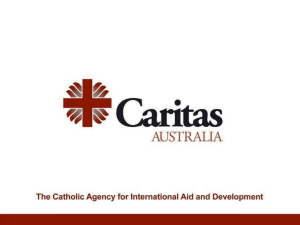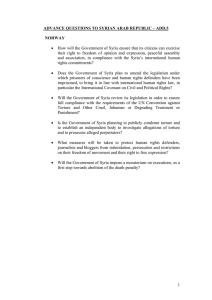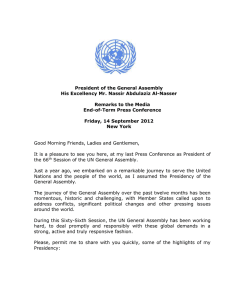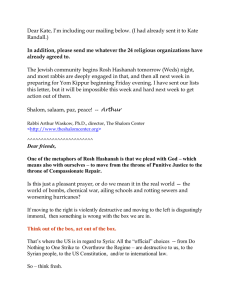An Unfolding Tragedy - Center for Complex Operations
advertisement
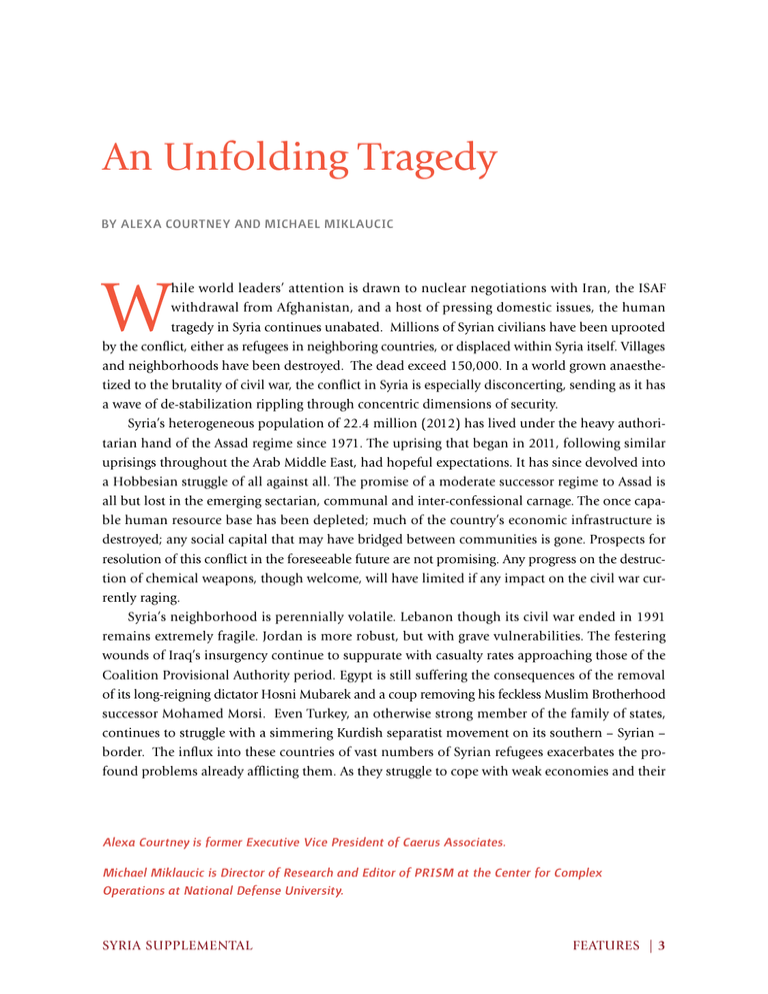
An Unfolding Tragedy BY ALEXA COURTNEY AND MICHAEL MIKLAUCIC W hile world leaders’ attention is drawn to nuclear negotiations with Iran, the ISAF withdrawal from Afghanistan, and a host of pressing domestic issues, the human tragedy in Syria continues unabated. Millions of Syrian civilians have been uprooted by the conflict, either as refugees in neighboring countries, or displaced within Syria itself. Villages and neighborhoods have been destroyed. The dead exceed 150,000. In a world grown anaesthetized to the brutality of civil war, the conflict in Syria is especially disconcerting, sending as it has a wave of de-stabilization rippling through concentric dimensions of security. Syria’s heterogeneous population of 22.4 million (2012) has lived under the heavy authoritarian hand of the Assad regime since 1971. The uprising that began in 2011, following similar uprisings throughout the Arab Middle East, had hopeful expectations. It has since devolved into a Hobbesian struggle of all against all. The promise of a moderate successor regime to Assad is all but lost in the emerging sectarian, communal and inter-confessional carnage. The once capable human resource base has been depleted; much of the country’s economic infrastructure is destroyed; any social capital that may have bridged between communities is gone. Prospects for resolution of this conflict in the foreseeable future are not promising. Any progress on the destruction of chemical weapons, though welcome, will have limited if any impact on the civil war currently raging. Syria’s neighborhood is perennially volatile. Lebanon though its civil war ended in 1991 remains extremely fragile. Jordan is more robust, but with grave vulnerabilities. The festering wounds of Iraq’s insurgency continue to suppurate with casualty rates approaching those of the Coalition Provisional Authority period. Egypt is still suffering the consequences of the removal of its long-reigning dictator Hosni Mubarek and a coup removing his feckless Muslim Brotherhood successor Mohamed Morsi. Even Turkey, an otherwise strong member of the family of states, continues to struggle with a simmering Kurdish separatist movement on its southern – Syrian – border. The influx into these countries of vast numbers of Syrian refugees exacerbates the profound problems already afflicting them. As they struggle to cope with weak economies and their Alexa Courtney is former Executive Vice President of Caerus Associates. Michael Miklaucic is Director of Research and Editor of PRISM at the Center for Complex Operations at National Defense University. SYRIA SUPPLEMENTAL FEATURES | 3 COURTNEY AND MIKLAUCIC own political tensions, the contagion of conflict threatens to engulf them. Cross-border fault lines link these countries inescapably together. This is the heartland or core of the broader Middle East, North Africa (MENA) region. Rumbling in the core ripples through the entire region, with impact detectable along the entire southern Mediterranean littoral, as well as in the Gulf and further east. Saudi Arabia, Qatar, the United Arab Emirates, and Iran are deeply invested in the Syrian conflict, each supporting their favorite faction. Needless to say the ramifications for the security of Israel and European democracies are profound. images are significant in international relations, and the image America is currently projecting is decidedly passive. A larger struggle in the region pits the Islamic Republic of Iran against Saudi Arabia for leadership within the world of Islam. Syria forms the land bridge between Iran and its most prominent protégé, Lebanese Hezbollah. Bashar Assad’s Alawite regime is a key element in the Shia coalition that now includes Iraq with outposts in the Arab Gulf countries. Syria is a majority Sunni country – as goes Assad so goes the Shia regime, and the direct link between Iran and Hezbollah. These are stakes both Iran and Saudi Arabia appear willing to go to the matt for. And how does this all affect the United States? Americans are justifiably exhausted by expeditionary campaigns in far-away places, having spilled vast amounts of blood and treasure in Iraq and Afghanistan with very little apparent return on the investment. What appetite there once was for reconstruction, 4 | FEATURES stabilization, and counterinsurgency, not to mention state-building, is gone. The problems of Syria seem remote to Americans. They are not as remote as many think though. The humanitarian tragedy in Syria as well as the immediate risk of spillover of the violence into American allies such as Jordan, Turkey, and Israel put Syria irremovably on America’s radar. More significantly American reticence in the MENA region is beginning to look like withdrawal from the region. Though the American administration has protested that the “rebalancing toward Asia” will not come at the expense of other key regions, indeed America appears to be bowing out. American leadership has been absent throughout the region lately – in Egypt, Libya, and now in Syria. America’s allies have noticed. There are many explanations for America’s strategic decisions, but images are significant in international relations, and the image America is currently projecting is decidedly passive. This comes with a cost as America’s allies no longer feel assured of American commitment. It is a slow, but tectonic shift. Geo-strategy has long acknowledged the fundamental importance of location - proximity, insularity, topography, resources. We must now equally acknowledge the importance of timing. The velocity of political events and processes is such that windows of opportunity open and close in the blink of an eye. Decisive action two years ago, or even six months ago might have incurred risks, or even have failed, but might also have averted the current catastrophe in Syria. A no-fly zone over Syria in 2011 might have enabled the Free Syrian Army to defeat Assad regime forces, thus possibly avoiding the chaos that permitted radical salafi domination of the battlespace. A punitive U.S. SYRIA SUPPLEMENTAL AN UNFOLDING TRAGEDY strike against the regime after it crossed the chemical weapons redline might have prevented Syria’s further descent into chaos. Those options are no longer available. Officials and analysts now contemplate a deal with the oppressive Assad regime. Others propose dialog with the least radical of the salafi jihadists. However, it now appears likely a protracted struggle will ensue, punctuated by international negotiations removed from the violence in Syria itself. Therefore, an outcome favorable to U.S. national security seems hard to imagine. How did things reach this point? It is incumbent upon us to pose the awkward question, “Was the course taken the best to protect American interests and at what cost to our national security?” PRISM journal’s inaugural supplemental issue explores the complexities of Syria’s violent transition through a broad spectrum of Syrian and American voices. The contributions in this edition underscore the complex nexus of political, social, and economic challenges threatening Syria’s future, and highlight the profound impact of chronic instability on Syria’s citizens and neighbors. Many of the authors cautiously advocate military, diplomatic, or development engagements designed to interrupt the cycle of increasing violence and bring Syria back from the brink of selfdestruction. This issue of PRISM offers readers insights into Syria’s struggle in an effort to catalyze cooperation across boundaries— between communities in Syria fighting for their survival; and committees in Washington and international capitals charged to develop responsible engagement policies. We hope the perspectives reflected in this issue will ignite readers’ creativity and commitment to influencing positive change on the ground in Syria. SYRIA SUPPLEMENTAL This special PRISM supplement dedicated to Syria is the product of a partnership between the Center for Complex Operations (CCO) at National Defense University and Caerus Associates, a strategy and design firm that has been conducting primary research on the ground in Syria since late 2012. PRISM and Caerus collaborated throughout 2013, as the situation in Syria changed by the day. The essays and interviews were submitted and done during the course of 2013, and naturally reflect the evolving circumstances of a highly complex and tragic situation. By joining forces to publish this issue, we amplify the voices of Syrian scholars, advocates, and officials and provide context to the ongoing policy debates highlighted in this issue by American academics, diplomats, and practitioners. The contributions in this edition are diverse and reflect a wide range of styles including feature articles, interviews, opinion pieces, an info-graphic, and a fictitious policy brief from within the Assad regime. We hope this issue of PRISM will inspire readers’ empathy for the daily struggles weathered by the Syrian population; deeper under‑ standing of the interrelated dynamics fueling the chronic conflict; imagination of new approaches to interrupt the violence and insecurity; and, ultimately, action for a safe and peaceful future for Syria. PRISM FEATURES | 5
